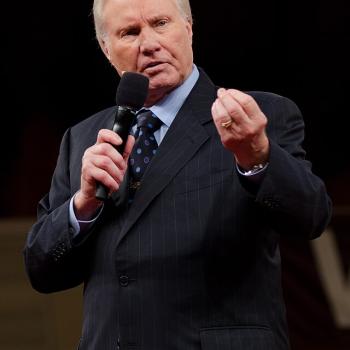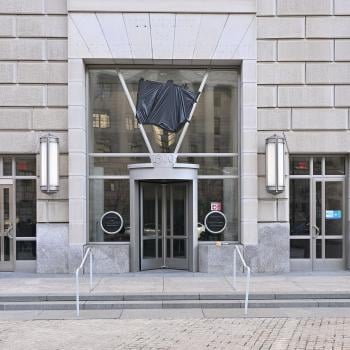Follow Up to My Post about Denominations…
Over the past year I have read many news articles in various sources claiming that church attendance in the United States is dramatically decreased. The statistics vary a lot, so I won’t bother to offer any here. My point is simply that, according to many journalists and other observers and commentators, Americans are flocking away from churches.
*Sidebar: The opinions expressed here are my own (or those of the guest writer); I do not speak for any other person, group or organization; nor do I imply that the opinions expressed here reflect those of any other person, group or organization unless I say so specifically. Before commenting read the entire post and the “Note to commenters” at its end.*
As I work on my editing project for the 14th edition of the Handbook of Denominations in the United States I am, indeed, seeing somewhat alarming decreases in many denominations’ reports of membership. However, I believe this has to be kept in perspective; certain ameliorating facts have to be taken into account. They rarely are–by journalists, for example.
First, many denominations have finally begun to cull from their membership lists members who have not darkened the door of any of their congregations in years. I have personally been involved in several such projects. One church had twice the number of “members” as regular attenders and many of the “members” had either died or moved far away. They had been reporting them to their associations or denominational entities as their members for many years.
Second, on the other hand, many denominations have many more attenders than members. This is a little known fact about especially Pentecostal churches and denominations. There are other examples that are not Pentecostal but also “high demand” in terms of real membership.
Third, during the past several decades totally independent churches and unaffiliated denominations have simply exploded on the American religious scene. By “exploded” I mean come into existence and grown by leaps and bounds. Let me offer just one example. Any careful observer of the American religious scene know about this phenomenon.
A large bowling alley just blocks from my house, past which I have driven for many years almost every day, recently closed and was purchased by an independent evangelical congregation that is unaffiliated with any denomination. The church renovated the bowling alley into a church building. Every Sunday morning I see the parking lots (front, side, back) jammed with cars. I would estimate about 300 cars.
Now I am quite confident that this congregation is unknown to statisticians of religious bodies to say nothing of journalists who seemingly joyously report about the downturn in church attendance in America.
I travel quite a bit and stay in hotels. A couple years ago I was staying in a large hotel in a major northern U.S. city and witnessed the enthusiastic gathering of a large group of people in the hotel’s first floor ballroom on a Sunday morning. It turned out to be a Pentecostal congregation begun by a husband and his wife primarily for older Christians who were tired of “contemporary worship” and began gathering to sing “old time hymns” and worship in the “old ways.” I would say the church drew about 200 people on Sundays. It may have grown bigger because it has moved from that hotel–possibly because they outgrew the ballroom!
Anyone who is paying attention knows that these completely independent Christian congregations, accountable to no denomination or hierarchy, have popped up in vast numbers across America in the last few decades. Along with that phenomenon have arisen many new denominations or “denominetworks”–often growing out of large, very enthusiastic, independent churches that “plant” satellite churches. Who is keeping track of all of them? How? I could easily identify several such right in my own region. Okay, I will name one for skeptics. It’s hardly the only one, so you’ll just have to take my word for that.
In the city where I live exists a very large, very lively independent Renewalist (not quite Pentecostal but sort of) church called Antioch Community Church which is rapidly expanding outward with church plants and already existing independent, similar churches coming into its fellowship and under its supervision. So far as I know nobody is counting this church or its fellowship of churches in their estimates of American church attendance.
These case studies are not rare; the phenomenon of totally independent churches and new “denominetworks” is absolutely astounding to anyone who is paying attention. But it is extremely difficult, if not impossible, to keep track of them in terms of statistics because most of these newer churches and denominetworks do not report their numbers to anyone.
Nor is this phenomenon only regional. (I have to say this to head off the predictable response that this is “only true in the South.”) That is simply not the case. When I travel in any region all over the U.S. I pay special attention to the churches I see in towns and villages and cities. Very many of them appear to be independent. I then look up some of their web sites and find that, indeed, they were simply started by some “called of God” evangelist or self-appointed pastor. Often they are not even incorporated.
So why do most people–including journalists who crow about declining church attendance in America–not know about this phenomenon? Well, there are very, very few religion journalists working for major magazines and newspapers anymore. That’s another thing I have noticed. Everywhere I go I scour the local newspaper’s “Religion Page” if such even exists anymore (used to be in Saturday editions). Rarely do I see the name of any reporter especially assigned to that “beat.” If so, he or she is also assigned to the food “beat” (or something else).
There used to be “big name” religion reporters who worked for the major news magazines and major city daily newspapers. There are hardly any anymore whose sole “beat” is religion or, if that is his or her sole “beat,” knows much about religion below the surface.
So, when I read or hear that “church attendance in America is down” I wonder to myself (and now here, of course) if the reporter knows about the phenomenon of totally independent, unaccountable congregations often simply started in entrepreneurial fashion by some self-appointed evangelist, minister or whatever.
I doubt it.
*Note to commenters: This blog is not a discussion board; please respond with a question or comment solely to me. If you do not share my evangelical Christian perspective (very broadly defined), feel free to ask a question for clarification, but know that this is not a space for debating incommensurate perspectives/worldviews. In any case, know that there is no guarantee that your question or comment will be posted by the moderator or answered by the writer. If you hope for your question or comment to appear here and be answered or responded to, make sure it is civil, respectful, and “on topic.” Do not comment if you have not read the entire post and do not misrepresent what it says. Keep any comment (including questions) to minimal length; do not post essays, sermons or testimonies here. Do not post links to internet sites here. This is a space for expressions of the blogger’s (or guest writers’) opinions and constructive dialogue among evangelical Christians (very broadly defined).












